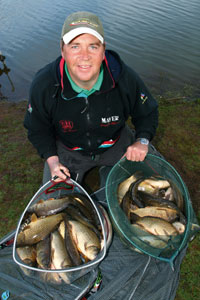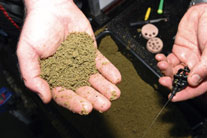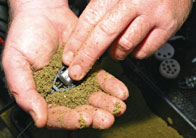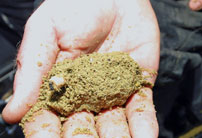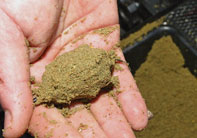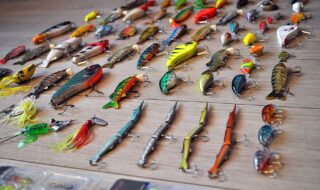The Method feeder is a devastatingly effective approach that can work in all but the coldest of conditions. It is simple in nature, but far from the chuck-it-and-chance-it tactic that some people believe it to be.
Over recent years, fishing the Method has become extremely refined and, as with any tactic, the better anglers will always catch more fish. There is definitely a lot of skill involved and consistent, accurate casting is vital to build up the swim and keep the fish coming.
After this, the groundbait and hook-bait combination is the next most important aspect. Getting all of these things right will put more fish in the net and separate the winners from the also-rans.
Where To Fish
Where to cast all depends on the nature of the venue. If you have a feature in front of you, such as an island, it obviously makes most sense to cast to that. Usually, the tighter you cast to the feature the better, but it is always worth trying shorter every now and then to pick up any fish hanging off the feed, especially on steeply sloping swims.
If the venue is ‘double-banked’ with anglers pegged opposite you I would never cast halfway at the start. Instead, drop the feeder short of the middle and see how sport develops. If people are catching better towards the middle then you can always chase them further out.
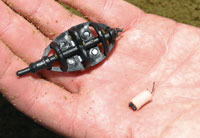 |
| Punched polony has almost neutral buoyancy. |
On large, open expanses it often pays to give the feeder a big chuck to outcast those anglers pegged around you. This way you have more water to yourself to draw fish from. Sometimes, if you are casting far enough, you can then confidently feed a second swim within pole range and periodically try the Method feeder over here. I would normally ball in 10 balls of groundbait on this closer swim and top up with another ball every so often while you are not fishing it. If this swim produces well then you can always switch to a pole rig and see if that catches faster.
Hook Baits
It definitely pays to experiment with hook baits and my personal favourites are dead red maggots, Peperami or polony.
Dead maggots are perhaps the most reliable bait and I use one, two or three on the hook – three is normally best. Peperami is a nice spicy alternative that will catch all species, not just carp. I use the Red Hot variety. Punched polony is also excellent as it is slightly buoyant and therefore easy for a fish to suck in.
For these last two baits I punch out cylinders using a 1/4in or 8mm bait punch. I prefer to use a standard loop at the end of the hair and conventional hair stops, because other devices have a tendency to snap off if they get caught in your landing net.
Ring the changes with the hook bait and vary between having them buried in the Method ball and sticking out, to see what the fish prefer on the day – no two days are ever the same.
You don’t just have to rely on a lone hook bait nestling among the groundbait, either. I will sometimes add one or two loose offerings such as bits of punched meat in each Method ball. I am sure this can attract a couple more fish over the course of a match.
|
|
||||
|
|
The Mix
Two kilos of groundbait should be more than enough for a typical session. I like a slightly damp, pellet-based mix that breaks down quickly once the feeder hits the bottom. You don’t want the mix to stay around the feeder and it needs to be fine and low in feed so the only real food they get is your hook bait. An inert mix is also best so always mix it up well in advance, preferably the night before.
Feeding
Accuracy is crucial and I always use the line clip to help maintain distance. I like to punch the feeder out on the cast and lift the rod up as the feeder approaches the target. Once it hits the line clip I will follow it down by lowering the rod. Once the feeder has settled don’t point the rod all the way to the side as this will drag it off target. Instead, I point the rod almost straight out, at about 10 degrees to where it lands.
I like to make quick casts at the start and only leave it in for two or three minutes for the first half an hour. All the time I would be looking out for signs of fish. After this, experiment by leaving it in longer. Once the fish start coming try and time how long it takes to get a bite. If a pattern emerges, that should dictate how long you leave it in before recasting.
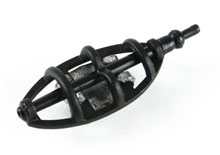 |
| Jamie prefers inline Method feeders. |
Rigs
I prefer inline Method feeders, which most fisheries seem to insist on now, and normally use medium-sized inline Craig O’Brien feeders from Maver. I run durable 6lb Maver Dual Band line through them and have the last six inches of line twizzled to create an extra-strong, doubled-up boom. At the end of the line I have a snap-link swivel so that I can change hooklengths quickly. This swivel is usually pulled back and wedged inside the end of the feeder to act as a safe, semi-fixed bolt rig.
I believe a short and stiff hooklength is harder for a fish to eject than a thinner and more supple one so I use thick, 0.20mm Genesis Extreme. The actual length depends on fishery rules but, where possible, I like a hooklength that is just long enough to fold back into the middle of the feeder to bury the hook bait. This could be as little as two inches or less at times.
As this is a self-hooking method, you need a sharp hook. I use spade-end Maver MT3s for dead maggots and eyed MT4s for hair rigging, both in a size 16.
For even more simplicity I use a two-piece, 12ft Maver Reactorlite feeder rod that can be assembled in seconds. The reel is a Tica SA4000.
Thanks to Maver Larford Lakes, Worcestershire, for the use of their lakes. Tel: 01299 829373.
Jamie Masson’s Top Tips
Accurate casting is vital.
Use your line clip to maintain distance.
Cast tight to features if you can.
Cast short of halfway if double banked.
On open-water venues outcasting your neighbours can work.
Ball in a shorter swim if you have enough room.
Experiment with hook baits.
Three dead maggots is one of the most reliable baits.
Use an inert, pellet-based groundbait.
A snap-link swivel helps you change hooklengths quickly.
Very short, stiff hooklengths are best.
Keep it simple!


